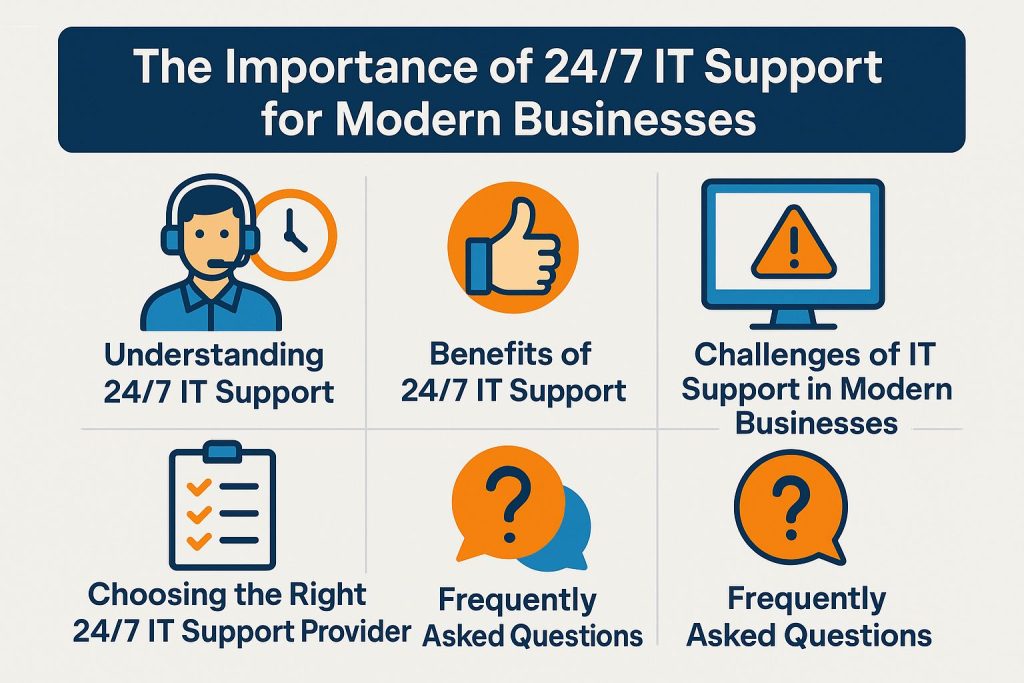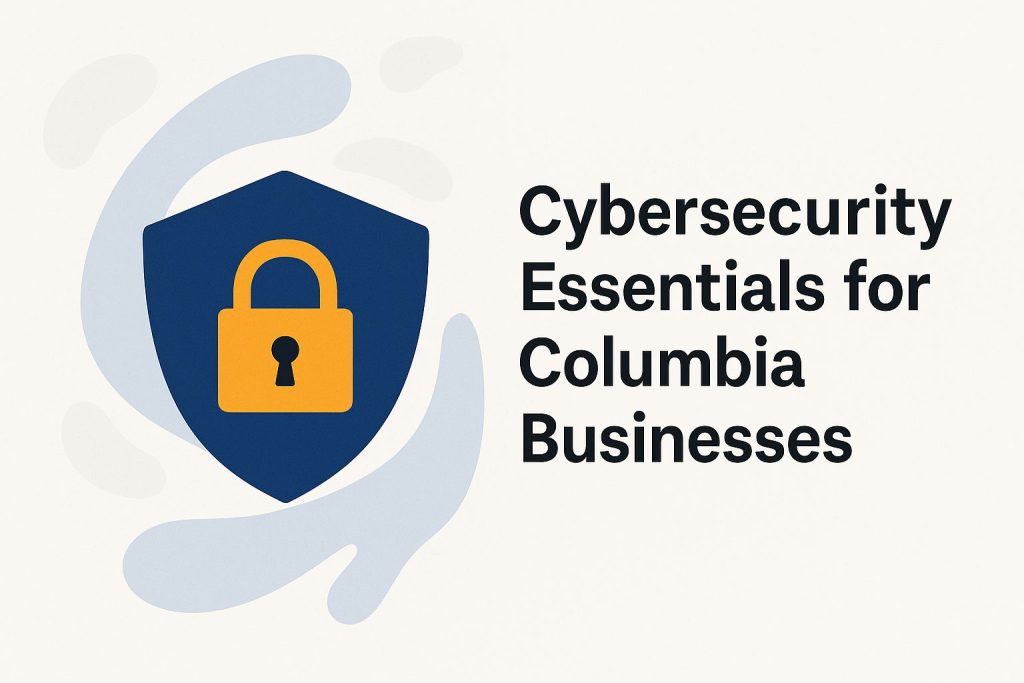IT Strategy Tips for Mid-Sized Businesses Scaling Operations

Today, a clear IT strategy is important for mid-sized companies that want to grow. As these businesses grow, they must align technology with their goals. This helps them become more efficient and innovative. This article examines the significance of developing an IT strategy tailored to the specific needs of the organization. Key points include: assessing the current infrastructure, identifying business goals, and building a strong IT team. Businesses should also invest in the right technologies. The following discussion will outline the steps necessary to elevate a business through strategic IT planning.
Understanding IT Strategy and Digital Transformation for Mid-Sized Businesses
Mid-sized businesses need to understand IT strategy. It helps improve operations and stay competitive in a digital world.
As these organizations confront the complexities of digital transformation, a well-defined IT strategy acts as a blueprint that aligns technology investments with overarching business objectives.
This process involves evaluating current IT infrastructure, using new software solutions, and optimizing operations for sustainable growth to foster sustainable business growth.
By emphasizing IT governance and risk management, mid-sized businesses can use IT governance and risk management to streamline processes. This helps them gain a competitive edge in their industries. Worth exploring: Managed IT Services for Local SMEs to see how operational costs can be reduced efficiently.
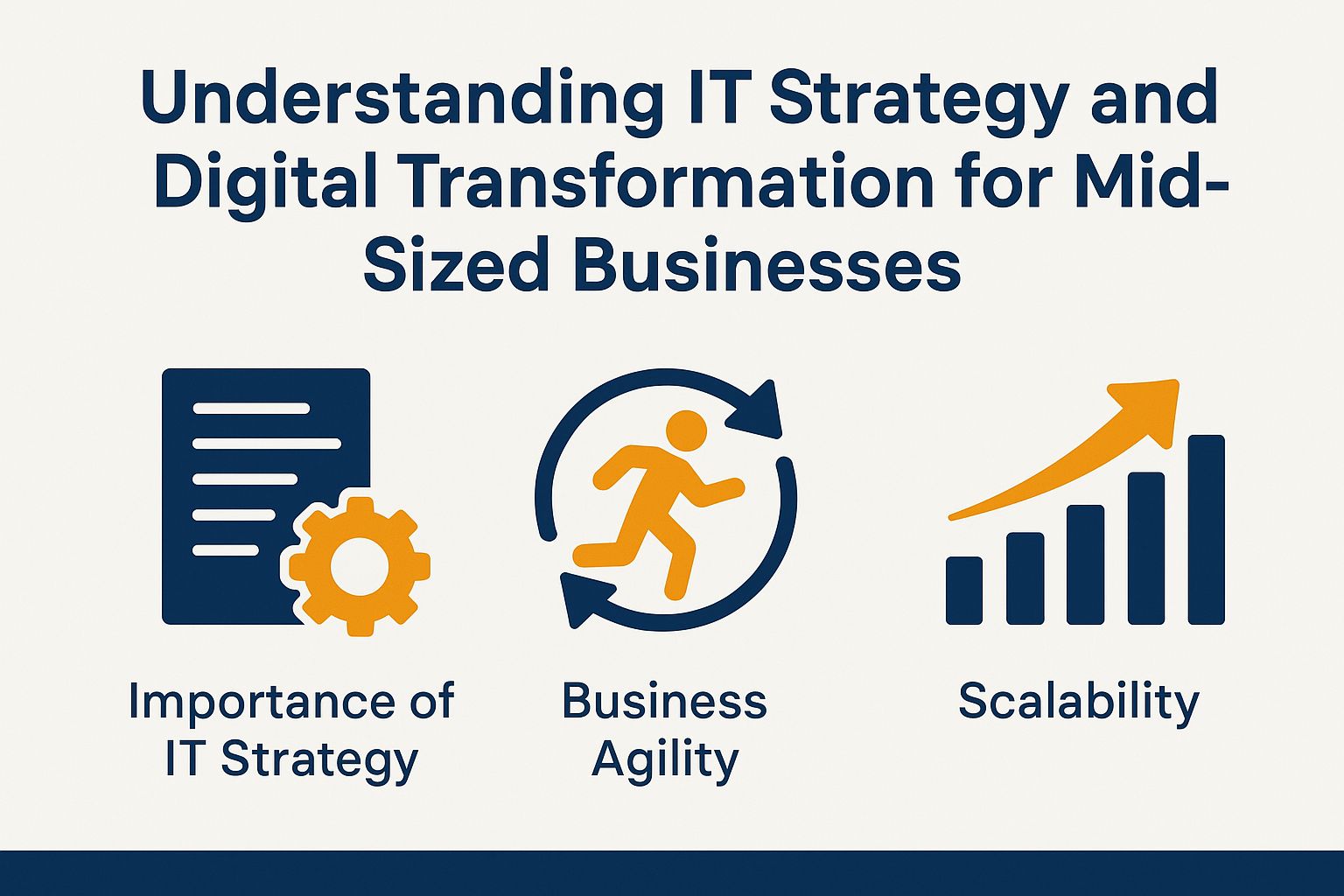
Importance of IT Strategy, Business Agility, and Scalability in Scaling Operations
An effective IT strategy is essential for mid-sized businesses. It helps them scale operations and adapt to market demands.
It acts as the backbone for enhancing operational efficiency by streamlining processes, minimizing redundancies, and enabling more effective resource allocation. With a well-defined technology roadmap, organizations can strategically adopt new tools and systems, ensuring that their technology landscape evolves in alignment with their growth objectives.
This alignment not only facilitates smoother transitions during periods of expansion but also enables businesses to leverage the advantages of emerging technologies, ultimately resulting in improved productivity, effective IT governance, and a stronger competitive advantage in the marketplace. For those interested in how to scale effectively, our insights into strategic IT consulting for growth could be invaluable.
Key Considerations and Technology Evaluation in Developing an IT Strategy
To develop an effective IT strategy, businesses must examine key factors that can greatly affect their success and performance. One crucial aspect is understanding how proactive IT measures can support business growth. For instance, implementing proactive IT monitoring can significantly enhance operational efficiency and security, as highlighted in our deep dive into proactive IT monitoring for growing companies in Columbia.
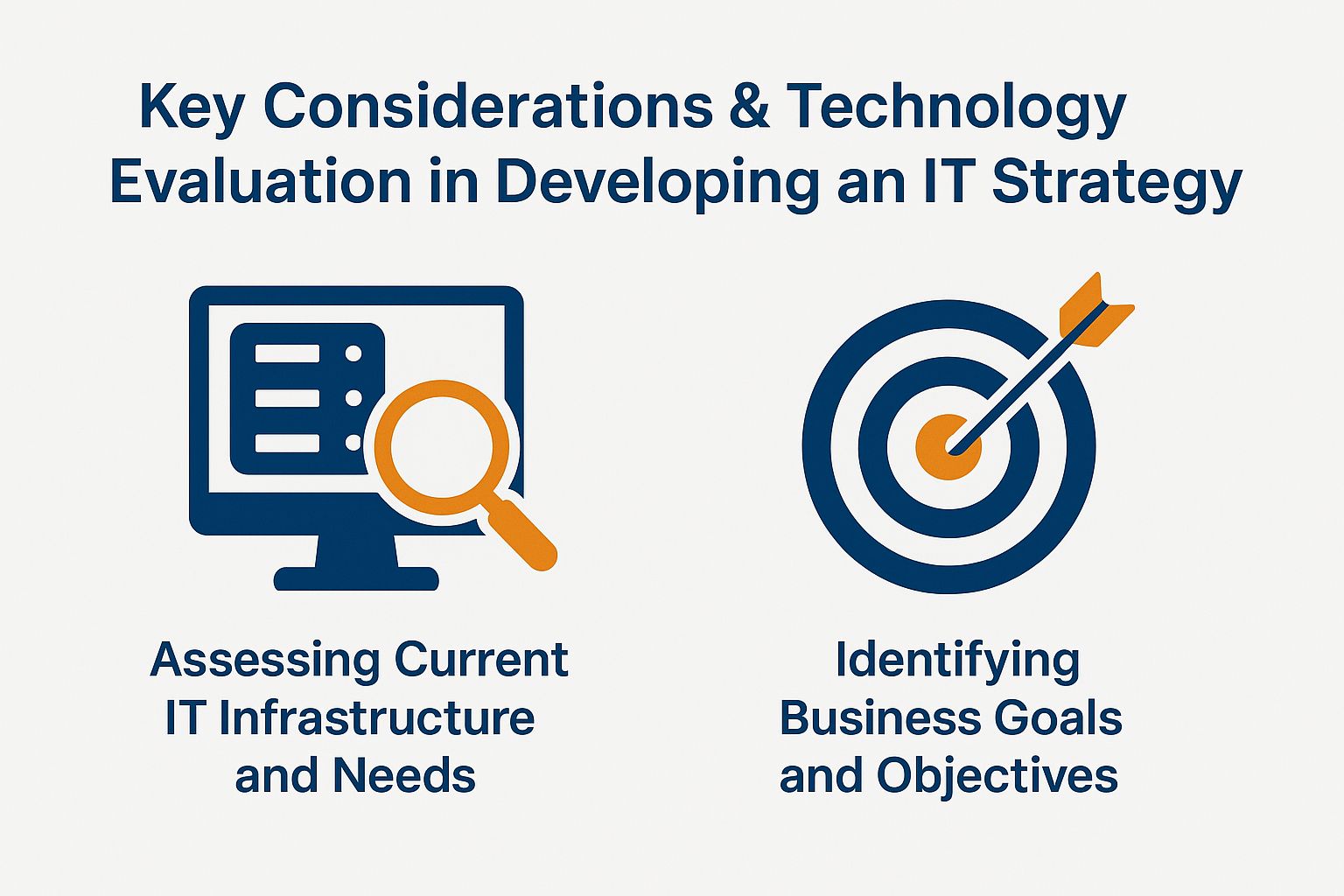
Assessing Current IT Infrastructure and Needs
Assessing the current IT infrastructure is key. It helps identify gaps and opportunities to improve efficiency and align with business goals.
This process begins with an examination of performance metrics and performance benchmarks, which provide insights into system responsiveness, uptime, and user satisfaction.
Following this, conducting a comprehensive IT audit is crucial for pinpointing vulnerabilities and inefficiencies within the existing setup. Methodically analyzing hardware, software, and network components lays the groundwork for knowledge management and decision making.
Once these evaluations are complete, the next step involves determining the necessary technology investments to effectively address the identified needs, ensuring that the organization remains competitive and prepared to embrace future challenges.
Identifying Business Goals and Objectives
Identifying clear business goals is essential. It ensures the IT strategy aligns with overall business planning.
Setting specific, measurable objectives provides a roadmap. This helps IT teams understand their role in achieving organizational goals. This alignment not only facilitates more focused resource allocation but also enhances communication across departments.
When all stakeholders work towards clear outcomes, it builds accountability and improves performance. The iterative feedback from these measurable objectives supports continuous improvement. It helps organizations adapt to changing market demands.
Ultimately, this strategic alignment supports business growth. It ensures that technology initiatives deliver value and contribute to the bottom line.
Implementing an Effective IT Strategy
Implementing an effective IT strategy requires a structured approach. This includes change management, project management, and promoting team collaboration for seamless execution, supported by service level agreements and performance evaluation.
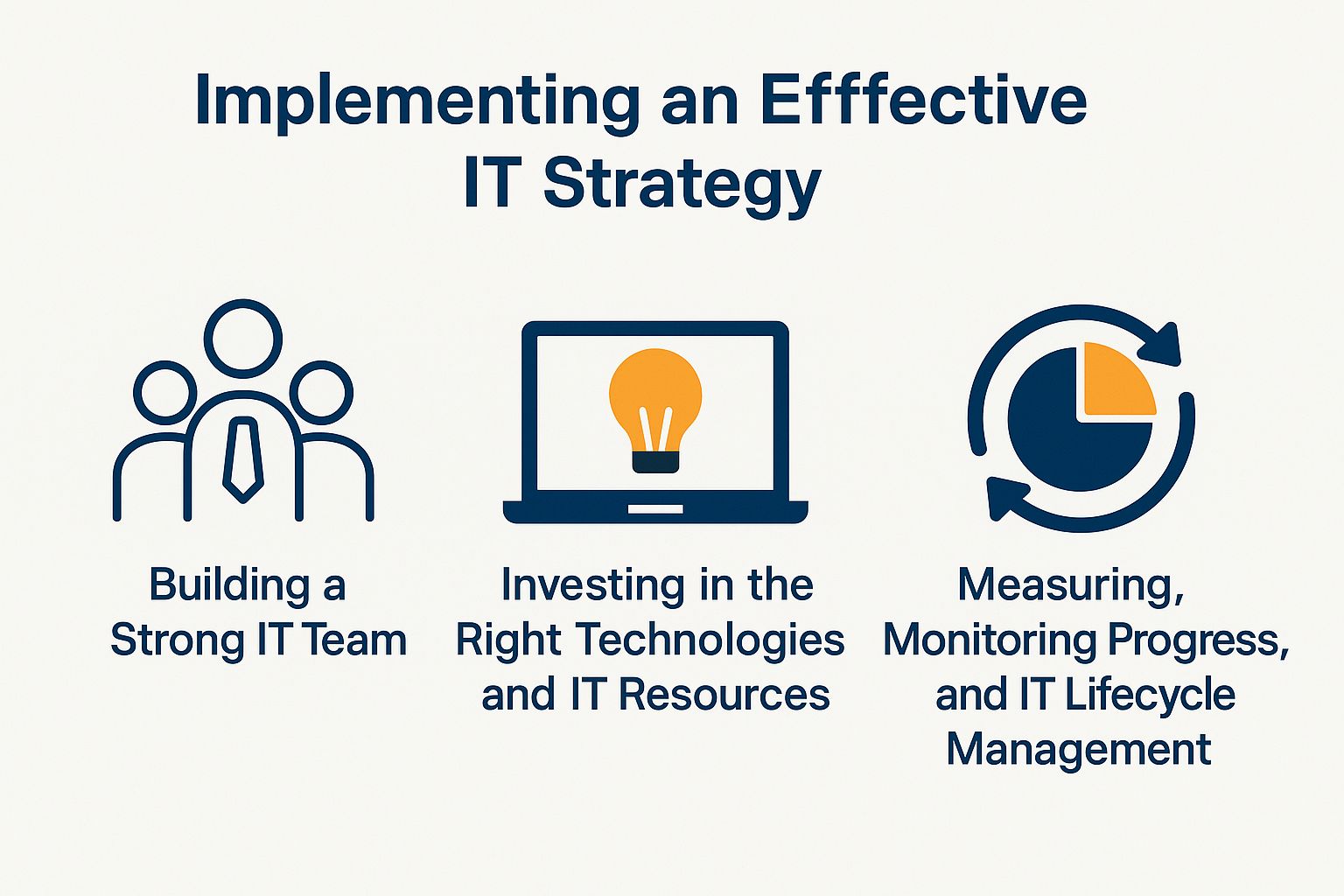
Building a Strong IT Team
Building a strong IT team is vital for executing an IT strategy. Skilled personnel are key for managing technology.
Organizations should prioritize staff training. This ensures the team stays informed about the latest technology trends and competencies. Fostering a collaborative atmosphere encourages each member to share insights and work together seamlessly, which is vital for troubleshooting and driving innovation.
Leveraging robust project management skills can streamline operations, ensuring that deadlines are met and resources are allocated efficiently. By implementing these strategies, companies can enhance overall operational performance, transforming their IT teams into dynamic powerhouses capable of driving business success.
Investing in the Right Technologies and IT Resources
Investing in the right technologies is crucial. It optimizes IT infrastructure and improves efficiency.
By carefully selecting solutions such as cloud computing and data analytics, these organizations can unlock valuable insights and streamline their processes.
The transition to cloud systems not only offers scalability and flexibility but also enables firms to innovate more swiftly by utilizing advanced tools without incurring significant upfront costs. Data analytics becomes an essential asset that informs decision-making, enabling businesses to predict trends and respond proactively to market demands.
Ultimately, these technological investments play a critical role in solidifying the IT strategy and business continuity, ensuring that mid-sized enterprises remain competitive and prepared for the future.
Measuring, Monitoring Progress, and IT Lifecycle Management
Measuring progress is essential. It evaluates the IT strategy’s effectiveness and ensures alignment with goals.
By implementing robust tracking methods for performance metrics and key performance indicators (KPIs), organizations can derive valuable insights into their operations. This process involves utilizing data analytics and automated reporting tools to collect real-time data, significantly enhancing decision-making capabilities.
Regular evaluations, including quarterly reviews and feedback loops, allow stakeholders to identify areas requiring improvement, facilitating timely adjustments. Ultimately, this systematic approach fosters accountability and contributes to the ongoing transformation of IT processes, ensuring sustained growth and productivity across the enterprise.
Frequently Asked Questions on IT Strategy and IT Outsourcing
What are some key IT strategy tips for mid-sized businesses looking to scale their operations?
1. Focus on flexibility and scalability. Your IT strategy should adapt to growth and changing needs while considering system integration.
2. Consider cloud solutions and software as a service: Cloud-based services can provide cost-effective and scalable solutions for storage, software, and infrastructure needs.
3. Don’t overlook cybersecurity: As your business grows, cyber threats grow too. Make sure to have robust security measures in place to protect your data and systems.
4. Leverage workflow automation: Automating routine tasks saves time and resources. This lets your team focus on strategic initiatives and business strategy.
5. Align IT with business goals: Your IT strategy should support your business goals. It must help your organization succeed.
6. Regularly review and update your strategy with change readiness: As your business changes, your IT strategy should change too. Regularly review and make adjustments to ensure it aligns with your current needs and goals, including regulatory compliance.
How can outsourcing help mid-sized businesses with scaling their IT operations?
1. Cost savings: Outsourcing IT services often costs less than hiring an in-house team.
2. Access to expertise: By outsourcing, you can tap into a wide range of specialized IT skills and experience that may not be available in-house.
3. Improved efficiency with vendor management: By delegating IT tasks to an external provider, your team can focus on core business activities, leading to increased productivity.
4. Scalability: Outsourcing allows for flexible scaling of IT services as your business grows, without the need to invest in additional resources. This approach has significant implications for business growth- our guide on strategic IT consulting demonstrates the practical application.
5. Proactive maintenance and support with remote work solutions: Many outsourcing providers offer proactive maintenance and support, helping to prevent IT issues before they occur.
6. Focus on core competencies: Outsourcing allows mid-sized businesses to focus on their core competencies and leave IT to the experts.
What are some common challenges mid-sized businesses face when scaling their IT operations?
1. Budget constraints: Mid-sized businesses often have limited resources, making it challenging to invest in new IT infrastructure or software development services.
2. Talent shortage: Mid-sized businesses often struggle to find and keep skilled IT professionals. They compete with larger companies for top talent in IT resources and IT governance roles.
3. Legacy systems: As businesses grow, they may struggle to integrate old systems with new technologies. This can cause compatibility and functionality issues affecting IT architecture and infrastructure planning.
4. Time constraints: With a growing business, there may be limited time and resources available to dedicate to developing and implementing a comprehensive IT strategy and agile methodology.
5. Data security risks: As businesses scale, they become more attractive targets for cyber attacks, increasing the risk of data breaches, network security threats, and financial losses.
6. Lack of alignment with business goals: Without a clear IT and investment strategy, mid-sized businesses may have trouble aligning technology investments with business goals.
How can mid-sized businesses ensure their IT strategy is aligned with their overall business goals?
1. Involve key stakeholders: When developing an IT strategy, it’s crucial to involve key stakeholders, including executives, department heads, and IT professionals, to ensure alignment with business goals and stakeholder engagement.
2. Identify and prioritize business needs: Clearly define your business goals and identify which IT solutions and functions are critical to achieving these objectives through effective IT governance and operational strategy.
3. Develop a roadmap: A strategic roadmap guides your IT decisions and priorities. It helps ensure alignment with your business and growth strategies.
4. Regularly review and adjust: It’s essential to regularly review and update your IT strategy to ensure it remains aligned with your evolving business needs, IT lifecycle management, and goals.
5. Communicate and educate: Share your IT strategy with all employees. Provide training so they understand how it supports the business and their roles within it, enhancing customer experience and user experience.
6. Measure success: Set measurable goals and regularly track and report on the success of your IT strategy in supporting overall business goals and conducting a comprehensive cost-benefit analysis.
What are some key considerations when choosing a cloud solution for a mid-sized business?
1. Scalability: Make sure the cloud strategy can easily accommodate your business’s current and future needs without incurring significant costs.
2. Security features: Find cloud providers with strong security, like encryption and regular backups. These protect your data from cyber threats and ensure privacy.
3. Compatibility: Check how the cloud solution connects with your current systems and applications.
4. Cost: Cost is important, but it should not be the only factor. Ensure the solution fits your budget and offers good value.
5. Service level agreements: Choose a provider with clear agreements. These should outline their responsibilities for uptime, support, and service.
6. Support and training: Ensure the provider offers enough support and training to help your team use the solution effectively.

